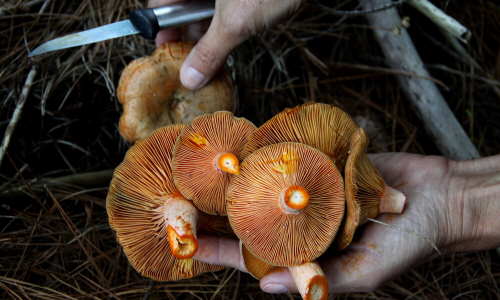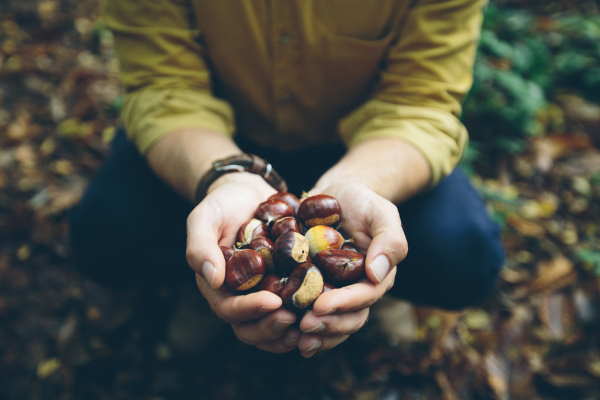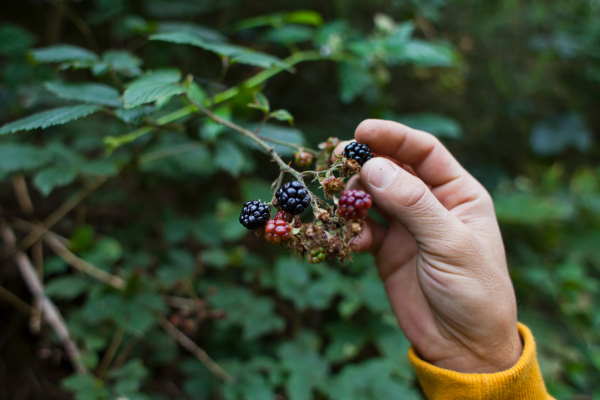
This article was originally published by Martin Banks on www.survivopedia.com
Once upon a time, hungry humans had nothing but the pristine land on which they dwelt to find a meal. Modern times have bred ignorance of many vital skills, among them how to locate food in the wild. As a result, otherwise intelligent, well-meaning hikers sometimes starve to death amid plenty when they get lost, simply because they don’t know where to look.
Where should you look? How can you get started? Here are five safe and easy ways to forage for nutrient-dense food.
Fortunately, it doesn’t require any special strength or ability to learn how to forage for food. Your best teacher is ultimately hunger — but you can make do with a curious mindset. It’s much less stressful to learn the ropes when your next meal isn’t on the line, but you want to develop the skill set in case things ever become that dire.
- Look for Water Sources
You could begin your foraging adventure by taking hints from the animal world — after all, this is their way of life. This approach will inevitably lead you to water, as those who follow game trails can attest. Humans are about 60% water, and many of the most nutrient-dense foods you’ll find in the wild thrive along waterways.
You’re lucky if you have equipment like a boat, especially if you live in the frozen north. You might be hard-pressed to forage much outside of pine needles and frozen fruits still clinging to trees if it’s January in Alaska. Take a tip from the Eskimos, who often rely on ice fishing to nourish themselves through the cold winter. It’s best to use the buddy system for safety, but ensure you carry a pick and know how to use it if you head out solo.

Fishing during the warmer months is an absolute joy. You can enjoy a hands-free experience if you invest in the right pole holder, kicking back in your boat and letting the sun kiss your skin. Fish provide an incredible source of lean protein. They’re also high in omega-3 fatty acids, crucial nutrients for your heart and neurological health. Sufficient intake of omega-3s reduces your risk of heart disease and stroke — some research suggests it can also improve mood.
However, you don’t have to descale all the fruits of the sea or river. Many tree varieties thrive along waterways. You might not recognize walnuts on the tree at first, as they look more like green apples — but they make a tasty plant-based protein source once you shuck the thick shell. Acorns make a delightful snack when roasted in a pan over the campfire.
You might associate grains with the prairie, but you can find ample varieties near waterways just about anywhere in the country. For example, you can eat nearly every part of the cattail plant, and reed grass can be steamed or pounded into flour. Watercress tastes divine in everything from soups to salads to sandwiches.
- Learn Edible Plants in Your Area
Your safest and easiest way to forage for nutrient-dense food requires you to do your homework. Research what grows wild near you and offers the most heaping dose of antioxidants and phytonutrients per serving. This list is by no means exhaustive, but it should get you started.
Disclaimer: This video content is for informational purposes only. Although the author and publisher have made every effort to ensure that the information is correct, the author and publisher do not assume and hereby disclaim any liability to any party for any loss, damage, or disruption caused by errors or omissions, whether such errors or omissions result from negligence, accident, or any other cause. The publisher and the author make no guarantees concerning the level of success you may experience by following the advice contained in this video.
The Great White North
You already know that the fruits of the sea can keep you laden with protein and healthy fats during the winter months. However, you could still go hungry even with sufficient caloric intake if you lack adequate nutrients.
Fortunately, pine needles are an incredible source of vitamin C. This nutrient is crucial for warding off colds in the frigid season, but it only works if you have it in your system when germs first strike. Learn how to make pine needle tea and drink at least one glass daily to prevent scurvy and the seasonal flu.
Nuts and seeds are also excellent nutrition sources, and you may find some in the winter. For example, pine nuts offer healthy fats. Is that an old pumpkin half-buried in the snow? The seeds will roast up fine in the oven with a dash of salt.
You won’t find many green shoots after the first snowfall. However, root veggies tend to last. See if you can scrounge the last of the season’s potatoes, beets and winter squash — perhaps a stray radish or two. For dessert, enjoy an apple, one of the latest-blooming trees. You can often find frozen fruit still clinging to the branches.
Temperate Forests
Temperate forests are an absolute bonanza — please don’t let yourself go hungry if you find yourself lost amid such bounty. Wild lettuce is spikier than its grocery-store kin and has a bitter flavor but is bursting with phytonutrients. It’s also used medicinally for treating chronic pain. You can enjoy all parts of the dandelion and even brew it into homemade wine.

You’ll find nuts in abundance, so gather them as a lean protein source. Don’t overlook those oily pine nuts for filling fats — a handful tossed into a thin winter vegetable soup makes it much more satisfying.
Pretty purple chicory makes an excellent coffee substitute. Berries abound during the summer — gather them at their peak and save them through drying or preserving. Collect plenty of elderberry for making winter cold remedies and perhaps a bit more wine. You might even stumble across some wild asparagus. However, use caution with carrots — they can resemble the deadly water hemlock, the stuff that killed Socrates.

The Open Prairie
You can find many of the same foods in temperate woodlands in the prairie, although you may have to wander through the corn rows to find stray patches of burdock and purslane. You’ll find no grain shortage, including the ancient amaranth. This plant is particularly beneficial because the leaves make a tasty salad green, and you can pound the seeds into a highly nutritious flour safe for folks with celiac disease.
You should find corn in abundance because grain crops blow in the breeze. That means seeds end up growing outside of farmers’ fields, and you don’t need to commit theft to forage.
You might have more luck finding edible flowers amid all that grain. Wood sorrel, wild mustard and coral honeysuckle feature bright hues that make them easy to spot. They taste delicious raw or brewed into tea.
The Desert
Yes, you can forage in the desert, often deliciously. For example, prickly pear fruit makes wonderful preserves that can lower your blood pressure. You can even prepare and eat the leaves once you remove the spines. Most cacti are somewhat edible, although you must make them the right way.
Mesquite seeds may look like pea pods but become magical gluten-free flour when dried and pounded. Chia seeds are one of the best plant-based sources of omega-3, and you’ll find them proliferating in the desert springtime. Wolfberries are considered the goji of the desert, thanks to their whopping antioxidant content.
Folks in the high desert will find many low-growing plants of the plains, like burdock, purslane and wood sorrel. Watch for imposing mullein — it’s edible and makes an impressive cold remedy.
- Get Cozy With Insects
Does the thought of munching on a cockroach turn your stomach? It shouldn’t. Millions of people worldwide depend on insects as a valuable food source.
Finding insects in the wild has a distinct advantage over plucking them off your apartment walls: no pesticides. You should generally avoid foraging insects from cultivated areas that might be treated with toxic chemicals. Fortunately, you should have no trouble finding beetles trundling along in the wild. Bake them in the oven, crush them and sprinkle them over your favorite veggie soup to add protein if you can’t stomach chowing down on roasted bugs.
Foraging is much easier in some months than in others. You need a way to save the hay you make during the sunshine to ensure adequate nutrition all year. Study up on the following storage methods for your cache:
- Cold storage: This can entail freezing or digging an old-fashioned root cellar.
- Canning: Canning can save food for months, but you need the right technique to avoid botulism.
- Drying and dehydrating: This method is probably the easiest for storing nuts, berries and grains.
- Preserves: Preserves aren’t only for PB&Js. They also keep your summer fruits fresh for use later in the winter.
- Salt: Adding salt reduces water where microbes breed. However, some modern folks avoid this method because of the effect sodium has on their heart.
- Pickling: This preservation method isn’t only for cucumbers. You can use it to save numerous vegetables, imparting a unique flavor.
- Fermentation: Fermentation doesn’t need to create alcohol. This method also imparts nourishing probiotics — think sauerkraut.
5. Go on the Hunt
Some evolutionary biologists argue that human beings would have never evolved had they not added meat to their diets. Animal foods offer complete protein and plenty of nourishing fat to keep you warm through the winter.
Fortunately, you don’t need a gun to hunt. You can set up a simple snare with a bit of rope and a piece of a sapling. Rabbit stew is rich and nourishing, and you can use the skin to make hand or foot coverings or a new hat.
Safe and Easy Ways to Forage for Nutrient-Dense Food
Foraging is a lost art, but you can revitalize it for modern times. Knowing how to find food in the wild comes in handy if you get lost and could keep you well-fed when tough times hit your wallet.
Follow the above safe and easy ways to forage for nutrient-dense food. You’ll nourish your body with the fuel it needs to survive in the wild — or make it safely back to civilization.




One Reply to “5 Safe and Easy Ways to Forage for Nutrient-Dense Food”